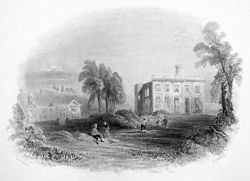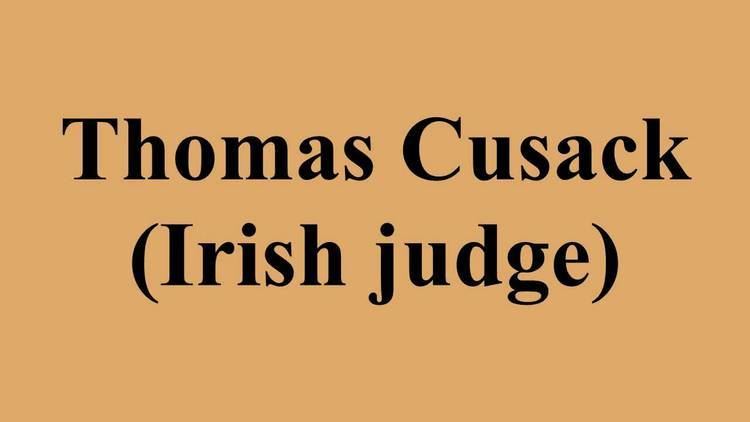Name Thomas Cusack | ||
 | ||
Sir Thomas Cusack (1490–1571) was an Anglo-Irish judge and statesman of the sixteenth century, who held the offices of Master of the Rolls in Ireland, Lord Chancellor of Ireland, and Chancellor of the Exchequer of Ireland. He was one of the most trusted and dependable Crown servants of his time, but led a somewhat turbulent private life. He was an ancestor of the Duke of Wellington. He is also memorable as the fourth of the six husbands of Jenet Sarsfield.
Contents
- Background and early career
- Career
- Politician
- Master and Chancellor
- Last years
- Death and memorial
- Marriages
- Descendants
- Character
- References

Background and early career

He was the eldest son of John Cusack of Cussington, County Meath, and his first wife Alison de Wellesley, youngest daughter of Sir William de Wellesley of Dangan Castle and his wife Ismay Plunkett. Both his parents came from long-established families of the Pale; he was a cousin of an earlier Thomas Cusacke who was Attorney General for Ireland in 1480, and Lord Chief Justice of Ireland from 1490 to 1494. After Alison's death John remarried Elinor Delahide of Moyglare Hall, County Kildare.
Thomas had four younger brothers and seven sisters, including
Dangan Castle, ancestral home of Thomas Cusack's mother, Alison de Wellesley
Career
Little is known of his life until he entered the Inner Temple in 1522, and became Master of the Revels there in 1524. He married his first wife Joan Hussey about 1515.
Like most ambitious Irishmen of the time, he saw the patronage of Thomas Cromwell, who was then virtually all-powerful at the English Court, as his patron; he lobbied Cromwell successfully for the Irish Chancellorship of the Exchequer, and on payment of £10, received the office in 1533. In 1534 when a vacancy opened on the Court of Common Pleas, he again lobbied for the office, with the assistance of his wealthy cousin Lady Neville, who spent £100 in bribes to obtain the office for him.
Despite his undoubted use of bribery to gain office, Cusack was highly regarded as a judge : O'Flanagan praises his practical common sense, his ability to discern the truth of any case and his minute attention to detail. He showed no prejudice against Irish -speaking plaintiffs and gained a reputation on the Bench for integrity and moderation.
Politician
Perhaps surprisingly, his first term as a judge lasted for little over a year. It is likely that the English Crown, which was well aware of his talents, thought that he could be more usefully employed elsewhere. He sat on a commission to inquire into the governance of Ireland, and later on the commission for the Dissolution of the Monasteries. For his good services to the Crown he received as his reward Lismullen Abbey, near Navan, despite the fact that his sister Mary was the Abbess of Lismullen: Mary was required to go through the humiliation of making a supposedly "voluntary" surrender of the Abbey into her brother's hands. Lismullen became one of the principal family residences, along with Cussington, but a bitter controversy over the rightful ownership of the Abbey led to years of litigation after Thomas' death. It remained in Cusack hands into the next century, when it passed by descent to the Dillon family. His father died, aged about eighty-two, in 1537, and Cussington also passed to Thomas.
He entered the Irish House of Commons and was elected Speaker in 1541, having been knighted the previous year. As Speaker he played a major role in securing the passage of the Crown of Ireland Act 1542, acknowledging Henry VIII as King of Ireland. His opening speech to the Commons as Speaker was an eloquent defence of royal policy, and in particular of the breach with the Papacy and the suppression of the monasteries. The Lord Justice of Ireland praised him as one who had done faithful and diligent service and cared for nothing but the King's honour.
In 1541 he furnished the King with a Treatise on the question of making gifts of land to his Irish subjects. True to his reputation for impartiality, he urged that the Old Irish be treated as subjects of the Crown, not its enemies, and that they be given the full benefits of English common law. This was in line with the new policy of "surrender and regrant". In opposition to those who urged extreme measures to suppress Shane O'Neill and, later, Gerald FitzGerald, 15th Earl of Desmond, Cusack constantly urged a policy of conciliation.
Master and Chancellor
In 1542 Cusack became Master of the Rolls in Ireland. This was still a relatively junior office, and at that time it was mainly administrative rather than judicial in nature. He had custody of all records of the Court of Chancery and power to hear lawsuits. He was appointed High Sheriff of Meath in 1543 and raised troops in that county for service abroad; he also assisted in the defence of the Pale in 1548.
Having already been appointed Keeper of the Great Seal in 1546, he was in 1551 made Lord Chancellor of Ireland by Edward VI on account of his "wisdom, learning, great experience and grave behaviour", and received an increase in salary. His duties were executive as well as judicial and he was sent to impose martial law in Connaught, where he showed considerable severity. O'Flanagan states that the judicial business of the Chancellor in his time was largely routine. He was appointed Lord Justice of Ireland, to govern in the absence of the Lord Deputy, in 1552. With Sir Anthony St. Leger, the strong-minded and turbulent Lord Deputy, Cusack unlike many of his colleagues was always on friendly terms.
Although Cusack was a strong supporter of the Reformation, the devoutly Roman Catholic Queen Mary I on her accession showed him no ill-will on account of his religious policy. Instead she wrote to him in glowing terms praising the diligent service he had given her brother for which she gave thanks, and continued him in office. He was later however to complain of the expenses he had incurred in her service.
Last years
He was superseded as Lord Chancellor in 1554. He returned to politics and was elected as member of the House of Commons for Athenry in 1559. He became personally known to Elizabeth I and performed a number of diplomatic missions on her behalf: he settled a dispute between Thomas Butler, 10th Earl of Ormond and Gerald FitzGerald, 15th Earl of Desmond in 1560, and negotiated with Shane O'Neill. In 1564-5 he showed considerable ruthlessness in the pacification of Munster. He was anxious to resume the Lord Chancellorship and lobbied repeatedly for it. It seems that he was actually promised a return to the office in 1563, but the promise was not fulfilled. He remained a valued member of the Privy Council of Ireland, though he often complained that his advice was not listened to.
Death and memorial
The Cusack family crest includes a Mermaid brandishing a sword as depicted on a family tree memorial stone for Sir Thomas
Although he complained of constant illness, Cusack like his father lived to be over eighty. He died in 1571 and is buried at Trevet, County Meath. A memorial to Cusack and his second wife Maud Darcy was raised in Trevet Church (now a ruin) and still exists in fragmentary form. Cusack praises his wife generously but his own good qualities even more:
"Virtue begat me. Piety cherished me. Honour increased me. Skill set me high. Let long lived renown hand down my days. As Lord Chancellor I administered the laws..".
Marriages
O'Flanagan's claim that Cusack led a simple domestic life hardly gives a full or accurate picture of his decidedly troubled private life. His first wife was a distant cousin, Joan Hussey, with whom he had at least three children. In 1537 the marriage was annulled on the grounds of the blood relationship, but it is likely that unhappy personal differences were the real reason for the end of the marriage. In later years Cusack was accused of inciting his servants to adultery with Joan to give him grounds for divorce; while this is probably untrue, it was noted that he always refused to admit that there had ever been a valid marriage between Joan and himself, and always referred to Maud Darcy as his first wife. Joan remarried a member of the Bathe family and was still living in 1581; Thomas, perhaps in a belated acknowledgment of her marital rights, left her a small legacy.
His second marriage was even more controversial, since Maud Darcy was rumoured to have had her first husband, James Marward, titular Baron Skryne, murdered by Richard Fitzgerald, a younger son of Gerald FitzGerald, 8th Earl of Kildare . She then married Fitzgerald, who was later executed for his part in the Silken Thomas rebellion, whereupon Maud quickly married Cusack. The marriage seems to have been a happy one, and the effigy on their tomb contains a warm tribute by Cusack to his "wife blessed". She belonged to the prominent Darcy family of Platten, County Meath: she was the daughter of George Darcy and his wife Jane Riccard, and the granddaughter of Sir William Darcy, Vice-Treasurer of Ireland.
After Maud's death Cusack became the fourth husband of the much-married Jenet Sarsfield. Though it was clearly not a love marriage (Jenet showed a keen interest in securing as much property as possible) it seems to have been reasonably happy. However a bitter feud developed between Jenet and her stepson Edward, and Thomas' will, which left Lismullen Abbey to his widow, led to years of litigation. Cussington passed to Thomas' grandson by his first marriage. Jenet died in 1598, having made two further marriages.
Descendants
By his first wife Thomas had at least three children, of whom one predeceased him. The Trevet effigy states that he and Maud had thirteen children, of whom three seem to have predeceased him. Of his sixteen children, eight can be identified with certainty:
From Catherine Cusack descended the Colley family who acquired the title Earl of Mornington. They changed their name to Wellesley (they had Wellesley blood through Thomas Cusack's mother Alison) and produced among numerous other descendants the 1st Duke of Wellington.
Character
Despite his somewhat troubled private life, his willingness to acquire monastic lands and his use of bribery to gain office, Thomas Cusack is generally judged to have been one of the finest public servants of his time : a modern writer calls him "one of the most loyal and respected political figures in Ireland" in his time.
